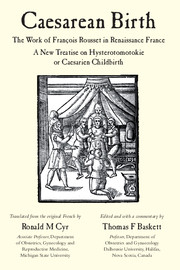 Caesarean Birth
Caesarean Birth Book contents
- Frontmatter
- Contents
- Acknowledgements
- Preface
- Translator's introduction
- François Rousset and the first text on caesarean section: a commentary by Thomas F Baskett
- A New Treatise on Hysterotomotokie or Caesarien Childbirth
- Sonnet
- Dedication
- Preface to the reader
- Part 1 Definition of caesarean childbirth
- Part 2 Second proof: logic (reason)
- Part 3 Third justification: expert opinion
- Part 4 Examples documenting other worse dangers from similar operations that are not caesarean
- Part 5 Other more popular justifications
- Part 6 On the fertility that remains after caesarean section
- A short guide to surgeons on the technique of caesarean
- Approbation
- Copyright
- Appendix 1 Summary of 16th century French history
- Appendix 2 Renée de France (1510–1575), Duchess of Ferrara, Chartres, Montargis and Nemours
- Appendix 3 Jacques de Savoie-Nemours (1531–1585), Duc de Nemours and Genevois
- Index
Translator's introduction
Published online by Cambridge University Press: 05 June 2014
- Frontmatter
- Contents
- Acknowledgements
- Preface
- Translator's introduction
- François Rousset and the first text on caesarean section: a commentary by Thomas F Baskett
- A New Treatise on Hysterotomotokie or Caesarien Childbirth
- Sonnet
- Dedication
- Preface to the reader
- Part 1 Definition of caesarean childbirth
- Part 2 Second proof: logic (reason)
- Part 3 Third justification: expert opinion
- Part 4 Examples documenting other worse dangers from similar operations that are not caesarean
- Part 5 Other more popular justifications
- Part 6 On the fertility that remains after caesarean section
- A short guide to surgeons on the technique of caesarean
- Approbation
- Copyright
- Appendix 1 Summary of 16th century French history
- Appendix 2 Renée de France (1510–1575), Duchess of Ferrara, Chartres, Montargis and Nemours
- Appendix 3 Jacques de Savoie-Nemours (1531–1585), Duc de Nemours and Genevois
- Index
Summary
Why now? Why, after more than 400 years, translate a French book about caesarean section? It would be facile to say, in the spirit of alpinism, ‘Because it was there’; yet Rousset's Traitte nouveau de l'hysterotomotokie ou enfantement Caesarien has been there for a long time. In truth, Renaissance scholars always could read the original French or Latin works, whereas obstetricians or others who might have been attracted to the subject matter were either unaware of Rousset or too linguistically challenged to read him with profit.
Caesarean section would not become a regular part of the surgical repertory until three centuries after publication of Rousset's hysterotomotokie. From contentious and inauspicious beginnings as a morbid operation ‘of necessity’, abdominal delivery has become a routine procedure during our lifetime. This has aroused new controversy, generating a great deal of interest in this subject within the medical profession and the educated public. The evolution – technical and sociological – of the caesarean operation has proved to be fertile ground for historical research. Tom Baskett, my editor, is among the medical historians who have been attracted to this topic and become aware of François Rousset's groundbreaking treatise – the first ever written about caesarean section. As a francophone obstetrician who shares the editor's interest in history, he asked me to consider translating the hysterotomotokie into English for the benefit of contemporary readers.
- Type
- Chapter
- Information
- Caesarean BirthThe Work of François Rousset in Renaissance France - A New Treatise on Hysterotomotokie or Caesarian Childbirth, pp. ix - xivPublisher: Cambridge University PressPrint publication year: 2010


